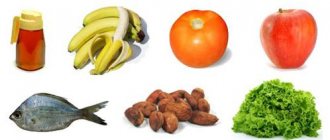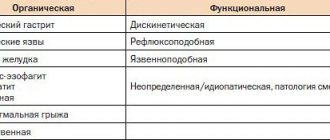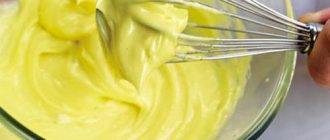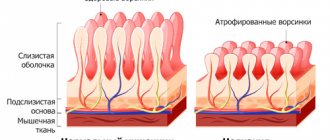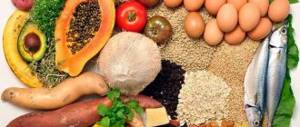May 2, 2020 Diseases
An allergy is an immune disorder that occurs when special substances called allergens enter the body. Allergens cause pain in the eyes, swelling, runny nose, skin rash in adults, headaches and other symptoms. Various substances can act as allergens; Some of the most serious allergens are certain foods. Let's find out what diet is needed for allergies in adults.
Food intolerance
Food allergy is the excessive sensitivity of the immune system to food products, expressed in the development of symptoms of partial or complete intolerance to certain foods. The development of the disease is caused by immune mechanisms. The prevalence of this problem affects up to 1/5 of the human population, and men are at risk in this regard more often than women. A dangerous complication of intolerance to a number of foods is anaphylactic shock: with it, the mortality rate reaches 20–40%.
The most “popular” food allergens:
- seafood;
- soy;
- nuts.
In early childhood, intolerance to eggs, milk, and oranges is often observed, but these phenomena often disappear as the child grows older (sometimes by the age of 2–3 years).
The influence of nutrition on the human body is difficult to overestimate
Primary prevention means:
- proper balanced nutrition of expectant mothers during pregnancy;
- limiting potential allergens in the diet when breastfeeding;
- When compiling a child’s menu, it is necessary to exclude preservatives, dyes, flavors, thickeners, and histamine liberators (foods that enhance the release of histamine).
At the place of residence
For adults, it is also impossible to compile an exact list of provoking foods, since it highly depends on the region of residence, as well as the race and nationality of a particular person. If we talk about residents of central Russia, they are statistically more likely to have allergies to the following products:
1. Sea fish, seafood.
2. Chicken eggs.
3. Certain types of citrus fruits (usually tangerines and oranges). Lemons, grapefruits and sweeties cause allergies much less often.
4. Nuts (hazelnuts, peanuts).
5. Honey and other bee products.
6. Poultry, lamb and beef.
7. Red and black summer berries - strawberries, raspberries, currants, blackberries, blueberries.
8. Ready-made mustard, as well as products that contain it (mayonnaise, salad dressing).
9. Cocoa and products containing it.
10. Grapes.
Reasons for development
When eating inappropriate foods, adverse reactions may occur in the human body, but only a limited number of them should be considered true food allergies.
People at risk should be aware that food allergens can change their properties during cooking and preservation. Some people whose bodies react violently to fresh fish will not harm themselves in any way by consuming canned fish.
Non-specific diet
This type of diet can be used for a variety of types of reactions - to certain foods, to pollen, etc. This is a fairly strict diet, because you need to completely exclude allergenic foods from your diet - milk, seafood, etc.
Article on the topic: Antiallergic diet Ado for children and adults
When dieting, you can eat the following types of foods:
- Fermented milk products.
- Cucumbers, cabbage, lettuce and other green vegetables.
- Different types of porridges.
- Oils – vegetable and butter.
- Lean meats.
- Regular tea.
- Still mineral water.
- Fruits – pears and apples.
As we can see, this list of products is quite wide, so you can easily alternate them when creating a menu for the whole week.
Symptoms
The clinical picture of food intolerance can represent a pathology not only of individual systems and organs, but also of the whole organism.
The first option includes external manifestations:
- skin reaction;
- itching;
- nasal discharge;
- cough;
- dyspnea.
Diet for allergies is one of the most important components of treatment, since during the period of exacerbation of the disease additional allergens may be added to the main allergen.
The second option involves detailed symptom complexes:
- Quincke's edema;
- anaphylactic shock;
- systemic urticaria.
Skin lesions in the case of a real food allergy are expressed in the clinical picture of atopic dermatitis and urticaria. When examining the organs of the digestive system, swelling of the oral mucosa, sore throat, and itching of the mucous membranes are noted. Such symptoms are triggered by ingestion of allergen-containing food and may persist for some time.
Possible development of esophagitis, constipation, diarrhea. Manifestations of nervous system pathology include weakness, dizziness, convulsions, and loss of appetite.
Products with lower allergen concentrations are limited, and the main diet consists of foods with low allergen concentrations
Generalized reactions of an allergic nature develop in chronological order as follows:
- taking an allergen product (chocolate, fish, strawberries, soy, nuts, eggs, etc.);
- swelling and itching in the oral mucosa and pharynx;
- dyspeptic symptoms;
- urticarial rash on the skin in different parts of the body;
- general skin manifestations;
- angioedema;
- hypotension.
Diet therapy against allergies
The main method of control is diet therapy. It is a method of treatment, which is based on the correct dietary menu, which allows allergy sufferers to forget about their illness.
The diet helps not only with allergies, but also in the treatment of other diseases and pathological conditions:
- Diseases of the gastrointestinal tract.
- Hepatic and renal pathologies.
- Diabetes.
- Obesity.
- Oncological diseases.
- Diseases of an infectious nature.
As for allergic reactions, it is diet and the right diet that will significantly reduce the symptoms or completely rid you of this disease.
The diet can be of two types - nonspecific and elimination. The first diet involves excluding certain foods that are classified as allergens. As for the elimination diet, it involves a more targeted approach aimed at eliminating foods that cause a negative reaction in a particular patient.
Establishing diagnosis
Diagnosis of allergies associated with food intake is prescribed by an allergist and is carried out in a designated treatment room. Scarification and prick tests are often performed. Scarification testing involves applying solutions of tested allergens to the scarified skin of the forearm and assessing the result (after 20 minutes) using a special scale. Prick tests are not fundamentally different from prick tests, with the exception of the method of applying the allergen through a skin prick.
It is necessary to test for various allergens to find out which foods actually cause a reaction and which do not.
In addition to the listed tests, the following methods can serve: an oral challenge study with preparations consisting of potential food allergens, a double-blind placebo-controlled study with a food allergen. The existing arsenal of methods is complemented by laboratory techniques for determining the concentration of total and specialized IgE, tryptase, histamine, IgG4, and RAST suppression.
Menu option
Weekly meal plan for allergy sufferers:
- Monday. Breakfast consists of low-fat kefir, cottage cheese salad (parsley, low-fat cottage cheese, dill, cucumber). For lunch, pea soup, rice with lean boiled beef, and unsweetened green tea are allowed. Dinner: potato casserole with cottage cheese, drinking water.
- Tuesday. For breakfast, you can prepare oatmeal with cherries and apples, and drink a glass of drinking water. Lunch: soup with beef meatballs, boiled potatoes with olive oil and dill, green tea. Dinner: cottage cheese casserole with raisins, apple compote.
- Wednesday. Breakfast consists of wheat porridge and kefir. For lunch you can eat milk soup, potato balls, and drink unsweetened tea. Dinner: water, pasta with sauce.
- Thursday. Breakfast: cabbage salad (cucumbers, cabbage, olives, dill, apple juice. Lunch: creamy potato soup, stewed zucchini in sour cream sauce, green tea. Dinner: pancakes with apples, cherry compote.
- Friday. For breakfast, apples with cottage cheese, kefir. For lunch, squash soup, cherry dumplings, tea. For dinner - drinking water, stewed cabbage.
- Saturday. In the morning, buckwheat porridge, apple compote. Lunch: vegetable soup with beef, zucchini pancakes, green tea. For dinner, cabbage cutlets and compote.
- Sunday. In the morning, juice or kefir, cottage cheese casserole. Lunch of lentil soup, compote, dumplings with beef. Dinner: potato cakes, compote.
Therapy
The main treatment methods for treating food allergies are:
- cessation of further development of pathogenesis;
- normalization of the patient’s general condition (elimination of the allergen from the human body in case of a real food allergy, nutritional correction that removes established and potential allergens from the diet).
Removing a product that causes an allergy involves stopping its entry into the body, sometimes by gastric lavage and taking intestinal enterosorbents.
If there is a medicinal form of allergy, there are no restrictions on the consumption of products
The main objectives of drug treatment are based on:
- reducing the concentration of histamine in the blood (antihistamines);
- stabilization of basophil membranes (Intal, Cromolyn, Cromosol);
- influence on the pathogenesis of allergy development (prescription of glucocorticoids orally and in the form of ointments);
- eliminating the consequences of real food intolerance (infusions, bronchodilators, decongestants).
Nutritional recommendations for children
To prevent the development of an allergic reaction in children, you must follow a few simple rules:
- The first complementary foods should be introduced no earlier than 6 months, especially for children with allergic parents.
- New components are added one at a time, with a break of several days, which the body needs to adapt to an unusual dish.
- Vegetables and fruits. Complementary foods should be as appropriate as possible for their region. A baby at this age does not need gourmet foods at all.
What to do if an allergy has already developed? How to calculate the “enemy” product? Of course, a more progressive way is to test blood to detect antibodies and conduct antigen challenge tests. But this is not always possible to do due to various reasons. In this case, keeping a “food diary” will help. First of all, if a child has an allergic reaction, it is necessary to introduce a strict diet:
- Completely exclude all red vegetables and fruits: carrots, tomatoes, strawberries, cherries, watermelons, red apples and others.
- The following should be removed from the diet: meat and fish of fatty varieties, as well as broths made from them; eggs, sausages and frankfurters; smoked meats and preservation. Whole milk and its products (except fermented milk), ice cream, chocolate, cocoa.
- Processing method: boiling, stewing, steaming, fresh.
After all symptoms and manifestations of allergies have completely disappeared, previously prohibited foods should be introduced using the same gradual principle as when introducing the first complementary foods. At the same time, the name of the product, method of preparation, date of consumption and the body’s reaction are carefully recorded in a notebook, which will be called the “Food Diary”. Thus, when the child’s body reacts with hypersensitivity to some product, the description of this product will be recorded, and in the future it will be removed from the daily diet.


